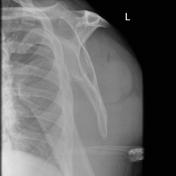Anterior shoulder dislocation
Diagnosis certain
Updates to Case Attributes
Body
was changed:
Typical appearances of an anterior glenohumeral dislocation.
Anterior shoulder dislocation is by far the most common type of dislocation of the shoulder, and one of the most common joint dislocations anywhere in the body. It usually results from forced abduction, external rotation and extension.
Anterior dislocations can be further divided according to where the humeral head comes to lie:
- subcoracoid - most common
- subglenoid
- subclavicular
- intrathoracic - very rare
-<p>Typical appearances of an anterior glenohumeral dislocation. </p>- +<p>Typical appearances of an anterior glenohumeral dislocation. </p><p><a href="/articles/anterior-shoulder-dislocation">Anterior shoulder dislocation</a> is by far the most common type of dislocation of the shoulder, and one of the most common joint dislocations anywhere in the body. It usually results from forced abduction, external rotation and extension.</p><p>Anterior dislocations can be further divided according to where the humeral head comes to lie:</p><ul>
- +<li>subcoracoid - most common</li>
- +<li>subglenoid</li>
- +<li>subclavicular</li>
- +<li>intrathoracic - very rare</li>
- +</ul>
Updates to Study Attributes
Images Changes:
Image X-ray (Frontal) ( update )

Perspective
was set to
Frontal.
Single Or Stack Root
was set to
.
Image X-ray (Lateral) ( update )

Perspective
was set to
Lateral.
Single Or Stack Root
was set to
.